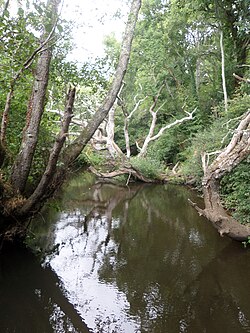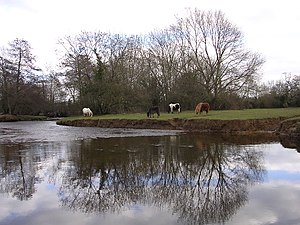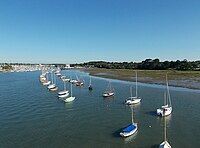Lymington River


The Lymington River drains part of the New Forest in the south-west of Hampshire. Numerous headwaters to the west of Lyndhurst give rise to the river, including Highland Water, Bratley Water and Fletchers Water. From Brockenhurst the river runs southwards to the Solent at Lymington. In all, the river is thirteen and a half miles long, the whole of it in Hampshire.
Highland Water rises north of the Ocknell Inclosure (SU243125) and flows for six miles to Bolderford Bridge (SU291041) where it meets Ober Water. From there, it is known as the Lymington River and flows for a further seven and a half miles to the sea (SZ340930).
The river's extensive reedbeds are a Site of Special Scientific Interest.
History

In 1731 a merchant navy captain, Captain Cross, constructed a causeway and bridge across the estuary to the north of Lymington.[1] He built toll houses and charged travellers using his causeway, more than a mile south of the existing bridge at Boldre.[2] This impedes the river and further silted up Lymington harbour, losing its minor shipping rapidly.[2] Lymington Corporation pursued the matter in court and lost their case.[2]
In 1795 the mud building up in the estuary "has rendered it already very narrow; and will probably in a few years, so completely choke it up, as to make it unnavigable by any ships of considerable burden."[3]
The causeway was taken over by the regional rail company, who collected the tolls until, after nationalised rail, it was bought out by the council in 1955, which eventually abolished the tolls.[2] Today silting in the harbour as a result of the causeway (which is almost a dam) occurs, but is ameliorated a higher sea level and the scouring effects of the Isle of Wight ferries.[1] Before the structure it is said the diurnal tide influenced flow up to Brockenhurst.[4]
Against the sea, the outer limit of the end of the estuary's mud at low tide is 600 to 700 yards closer to land than in 1895.
Location
- Location map: 50°47’53"N, 1°32’52"W
Outside links
| ("Wikimedia Commons" has material about Lymington River) |
References
- ↑ 1.0 1.1 Peter Bruce (2001) Solent Hazards, page 63 ISBN 187168031X
- ↑ 2.0 2.1 2.2 2.3 Jude James (2013) Lymington Through Time ISBN 1445629364
- ↑ D. Y. (1795) Collections for the history of Hampshire, and the bishopric of Winchester: Including the Isles of Wight, Jersey, Guernsey, and Sarke, Volume 1, Section 2, page 24
- ↑ David William Garrow (1825) The history of Lymington, and its immediate vicinity, page 29
